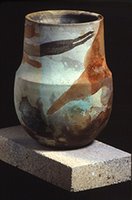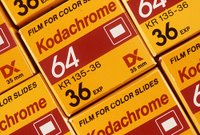
The young photographer and his bride rose early, dressed quickly, and then climbed into their fully packed station wagon. With a long drive ahead of them, they stopped at the drive-thru for a cup of coffee to keep them company. Their anticipation minimized the conversation. “Did we bring the hooks? Did you pack lunch?” covered most of it. This was a big deal. They were on their way to his first art fair.
He’d shown his photographs before, but only on a casual basis. He had a few pieces hanging at work which regularly elicited positive unsolicited comments. Dreaming that he had talent, she helped convince him to take the plunge. Applications were obtained. Slides prepared and sent. They kissed in elation at the arrival of the acceptance letter, then grimaced upon realizing the work and expense. But they were a strong and young couple. They had a love which bestowed mutual support, and that eccentric delusion of youth which promised them that they could go anywhere and be anything. Individually, they smiled inwardly this morning, each convinced that he was on his way.
They arrived at the city park near the river and located their chain linked booth near a large oak. It was a lovely summer morning. Unpacking came easy; excitement lightening the heavy boxes. With the care afforded a first home, they draped the neutral fabric over the garish fencing. They hung the work carefully, anticipating the eye movements of the coming crowd. They stepped back, then rearranged; thought and discussed; then they rearranged again.
The early crowd began to wander by as they were still perfecting their mini-gallery. Some stopped to look. Mostly they strode by, clutching either their spouse’s hand or their dog’s leash. It wasn’t until later that the kids with painted faces and the parents with wagons and strollers would arrive.
One reason he was here was to listen to what the public had to say about his work. He thought of himself as a serious photographer, but he wasn’t sure what others thought. Of course, whenever you asked anyone directly about your photographs, they always put on a polite smile and voiced an encouraging reply. He told himself that he didn’t care how little he sold. He told himself that what he really wanted an honest critic.
It was easy for him to eavesdrop on the crowd’s conversations, but he found little worth noting until later in the afternoon when a well dressed couple escorting a terrier stopped. They stood silently in front of his work, looking carefully at each image. Even their dog seemed to get into the act as he sniffed along the fence at the bottom of the booth. They spent some time gazing at his work. He could sense them internally evaluating his photographs. His breathing quickened. At last, someone was responding to his work. What would they say, he wondered?
Then came one of those absurd happenings, almost over before it even began. The photographer, his senses heightened with anticipation, experienced the moment in slow motion. He watched as the terrier lifted his leg and peed on his work. He wanted to shout, but nothing came out of his quivering mouth. The well dressed couple looked down, then at each other. Nodding their heads as if in agreement, they turned and left his booth. His most promising prospect of the day. Gone. Selling not a single print, he quietly cried on the way home as his wife fell asleep in the passenger seat.
 Photography’s dependent relationship with light goes far beyond the trivial statement that without light there is no photography. Most photographers operate under a incapacitating delusion: they do not recognize their true subject matter.
Photography’s dependent relationship with light goes far beyond the trivial statement that without light there is no photography. Most photographers operate under a incapacitating delusion: they do not recognize their true subject matter.










